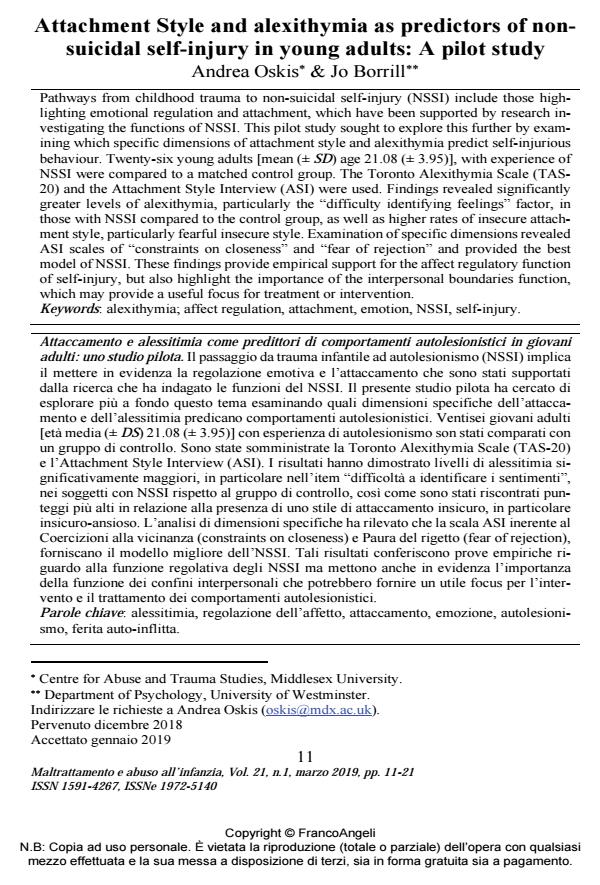Attachment Style and alexithymia as predictors of nonsuicidal self-injury in young adults: A pilot study
Titolo Rivista MALTRATTAMENTO E ABUSO ALL’INFANZIA
Autori/Curatori Andrea Oskis, Jo Borrill
Anno di pubblicazione 2019 Fascicolo 2019/1
Lingua Inglese Numero pagine 11 P. 11-21 Dimensione file 382 KB
DOI 10.3280/MAL2019-001002
Il DOI è il codice a barre della proprietà intellettuale: per saperne di più
clicca qui
Qui sotto puoi vedere in anteprima la prima pagina di questo articolo.
Se questo articolo ti interessa, lo puoi acquistare (e scaricare in formato pdf) seguendo le facili indicazioni per acquistare il download credit. Acquista Download Credits per scaricare questo Articolo in formato PDF

FrancoAngeli è membro della Publishers International Linking Association, Inc (PILA)associazione indipendente e non profit per facilitare (attraverso i servizi tecnologici implementati da CrossRef.org) l’accesso degli studiosi ai contenuti digitali nelle pubblicazioni professionali e scientifiche
Pathways from childhood trauma to non-suicidal self-injury (NSSI) include those high-lighting emotional regulation and attachment, which have been supported by research inves-tigating the functions of NSSI. This pilot study sought to explore this further by examining which specific dimensions of attachment style and alexithymia predict self-injurious behav-iour. Twenty-six young adults [mean (± SD) age 21.08 (± 3.95)], with experience of NSSI were compared to a matched control group. The Toronto Alexithymia Scale (TAS-20) and the Attachment Style Interview (ASI) were used. Findings revealed significantly greater levels of alexithymia, particularly the "difficulty identifying feelings" factor, in those with NSSI compared to the control group, as well as higher rates of insecure attachment style, particularly fearful insecure style. Examination of specific dimensions revealed ASI scales of "constraints on closeness" and "fear of rejection" and provided the best model of NSSI. These findings provide empirical support for the affect regulatory function of self-injury, but also highlight the importance of the interpersonal boundaries function, which may pro-vide a useful focus for treatment or intervention.
Il passaggio da trauma infantile ad autolesionismo (NSSI) implica il mettere in evidenza la regolazione emotiva e l’attaccamento che sono stati supportati dalla ricerca che ha indagato le funzioni del NSSI. Il presente studio pilota ha cercato di esplorare più a fondo questo tema esaminando quali dimensioni specifiche dell’attaccamento e dell’alessitimia predicano comportamenti autolesionistici. Ventisei giovani adulti [età media (± DS) 21.08 (± 3.95)] con esperienza di autolesionismo son stati comparati con un gruppo di controllo. Sono state somministrate la Toronto Alexithymia Scale (TAS-20) e l’Attachment Style Interview (ASI). I risultati hanno dimostrato livelli di alessitimia signifi-cativamente maggiori, in particolare nell’item "difficoltà a identificare i sentimenti", nei sog-getti con NSSI rispetto al gruppo di controllo, così come sono stati riscontrati punteggi più alti in relazione alla presenza di uno stile di attaccamento insicuro, in particolare insicuro-ansioso. L’analisi di dimensioni specifiche ha rilevato che la scala ASI inerente al Coerci-zioni alla vicinanza (constraints on closeness) e Paura del rigetto (fear of rejection), forni-scano il modello migliore dell’NSSI. Tali risultati conferiscono prove empiriche riguardo alla funzione regolativa degli NSSI ma mettono anche in evidenza l’importanza della fun-zione dei confini interpersonali che potrebbero fornire un utile focus per l’intervento e il trattamento dei comportamenti autolesionistici.
Parole chiave:Alessitimia, regolazione dell’affetto, attaccamento, emozione, autolesionismo, ferita auto-inflitta.
- Childhood Maltreatment and Suicidal Ideation: The Role of Insecure Attachment, Alexithymia, and Negative Urgency Surabhi Swaminath, Raluca M. Simons, Mahsa Mojallal, Mason L. Hatwan, Jeffrey S. Simons, in Journal of Aggression, Maltreatment & Trauma /2025 pp.1
DOI: 10.1080/10926771.2025.2606732 - The relationship between self‐harm and alexithymia: A systematic review and meta‐analysis Hilary Norman, Andrea Oskis, Lisa Marzano, Mark Coulson, in Scandinavian Journal of Psychology /2020 pp.855
DOI: 10.1111/sjop.12668
Andrea Oskis, Jo Borrill, Attachment Style and alexithymia as predictors of nonsuicidal self-injury in young adults: A pilot study in "MALTRATTAMENTO E ABUSO ALL’INFANZIA" 1/2019, pp 11-21, DOI: 10.3280/MAL2019-001002